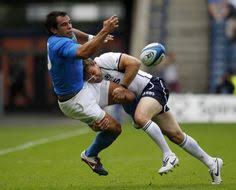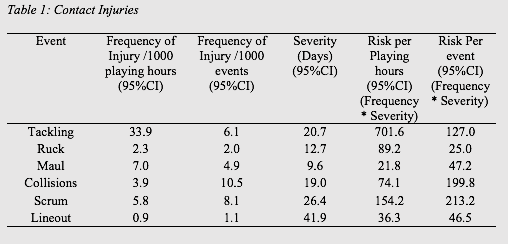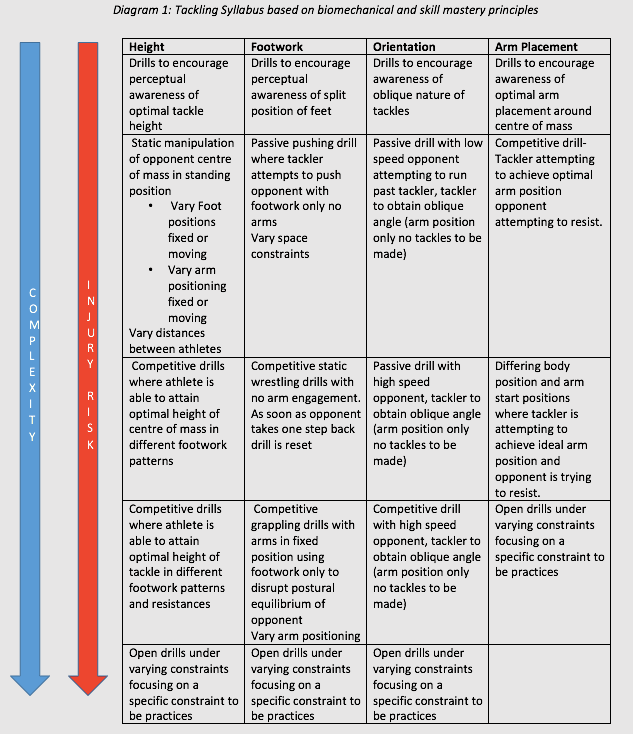Evidence Based Recommendations for a Tackling Syllabus in Rugby
- Shahbaz Hasan
- Apr 12, 2018
- 10 min read
Updated: May 12, 2018

Effective tackling skill is an integral part of rugby league and rugby union, both as an important determinant of winning games and to avoid injury (den Hollander, Brown, Lambert, Treu, & Hendricks, 2016; Diedrick & van Rooyen, 2011; Fuller, Brooks, Cancea, Hall, & Kemp, 2007; Mcintosh, Savage, Mccrory, FréChèDe, & Wolfe, 2010; Quarrie & Hopkins, 2008; van Rooyen, Yasin, & Viljoen, 2014; K. Wheeler & Sayers, 2009; K. W. Wheeler, Askew, & Sayers, 2010) In terms of performance, missed tackles and the ability to break tackles are key indicators of winning teams; they are specifically linked to line break opportunities which result in more tries (den Hollander et al., 2016; Hendricks et al., 2018; Hendricks, Roode, Matthews, & Lambert, 2013; K. Wheeler & Sayers, 2009).
Tackling has been extensively investigated within the scientific literature with many concerns over the frequency and severity of injury that tackling poses (Fuller et al., 2010, 2007; T. Gabbett & Ryan, 2009; Gardner, Iverson, Williams, Baker, & Stanwell, 2014; Hendricks, Till, Brown, & Jones, 2017). Tackling is the contact event within rugby union responsible, by far, for the highest frequency of injuries, highest risk per playing hours and highest average injury risk for a team, and all athletes have a requirement complete this particular contact skill (Table 1) (Brooks & Kemp, 2011; Fuller et al., 2010, 2010, 2007).
Authors have recently requested for a tackling skill development programme for athletes to reduce injury risks, based on the notion that adequate evidence now exists ,in understanding the tackle and how skills are developed (Hendricks et al., 2017). A prudent starting point would be to understand the skill from a biomechanical point of view so that the main kinetic and kinematic objectives of the skill can inform more applied practice (Bezodis, Trewartha, & Salo, 2015; Callaghan, Lockie, Jeffriess, & Nimphius, 2015; Fernandes et al., 2016). Secondly the ability for an athlete to both acquire and perfect the tackling skill is key (Gabbett, Jenkins, & Abernethy, 2011). As such, this article will detail how this skill can be developed using concepts from the skill acquisition literature, with a presentation of a tackling syllabus at the end of the article.

(Fuller et al., 2007)
The goal of a rugby tackle is for an athlete to be able to manipulate an opponent’s bodyweight such that the centre of mass falls outside of the base of support, which results in the opponent losing balance and falling to the ground (Hendricks et al., 2018; Horak, 2006; Tao & Yun, 2017; van Rooyen et al., 2014). This has previously been defined as postural equilibrium and as such the tacklers goal is to disrupt the postural equilibrium of the opponent (Horak, 2006). Owing to Newtonian mechanics, the management and distribution of forces will be key in achieving this task (Hall, 2015; Tao & Yun, 2017) Thus disrupting postural equilibrium will be achieved through the result of these aspects: the magnitude of force, the direction of the resultant force of the tackle and where forces are applied on the opponent (Hall, 2015). Evaluating this further, from an applied coaching perspective, four main technical aspects are generally considered in coaching recommendations to achieve these favourable magnitudes, direction and application points of forces. These are height that the tackle is made, foot positioning in the tackle, where the arms are placed on the opponent and finally the orientation of the tacklers body relative to the opponent (Hendricks & Lambert, 2010).
In evaluating the evidence, the height of the tackle should take place at around the centre of mass, which has been stated to be around 55-57% of standing height. If a tackle is high, and further away from the centre of mass, it would be more difficult for an athlete to disrupt postural equilibrium of an opponent; the opponent would be able to adjust their base of support so greater force would required to disrupt this adjustment (Hall, 2015; Hendricks & Lambert, 2010; Horak, 2006; Tao & Yun, 2017; Virmavirta & Isolehto, 2014). Another option is for the athlete to tackle very low, namely at the feet, so that the base of support is completely removed. However, this strategy is linked with high injury risks (Quarrie & Hopkins, 2008). A complicating factor is that the centre of mass is constantly changing with a dynamic task and, as such, the skill training will have to address both recognising the location of the centre of mass and the disruption of it (Virmavirta & Isolehto, 2014).
Foot positioning is linked to the direction of resultant force, as when foot position changes, torso position must change to allow the centre of mass to be maintained over the base of support (Kugler & Janshen, 2010). As an example, if the split position of the feet required in tackling is adopted, the torso must incline its position to maintain its balance (Hall, 2015; Horak, 2006; Kugler & Janshen, 2010). This change of body position is linked with greater propulsive horizontal forces (as evidenced in the acceleration literature), which will result in moving the opponent away from their try line while attempting to disrupt the postural equilibrium (Kugler & Janshen, 2010).
Arm positioning also influences where the force is applied, as pushing and pulling actions are executed by the arms of the athlete to manipulate the opponents postural equilibrium (Gabbett et al., 2011; Hendricks et al., 2018; Hendricks & Lambert, 2010; Mcintosh et al., 2010; van Rooyen et al., 2014). Importantly these application points should again be at the centre of mass of the opponent: the further away these forces are applied, the more force is required to disrupt the equilibrium due to the distance from the centre of mass and thus reduced efficiency (Hall, 2015; Horak, 2006; Virmavirta & Isolehto, 2014)
Finally, orientation of the tackler’s body to the opponent is an important consideration. Specifically, what is required is that the tackler approaches the tackle from an oblique angle which allows a more efficient disruption of the postural equilibrium ( Gabbett & Ryan, 2009; Hendricks et al., 2018; van Rooyen et al., 2014). This also links with traditional coaching cues that suggest that a tackle should be made leading with the shoulder closest to the opponent i.e. ‘inside shoulder’. If the tackler was to approach the opponent at a parallel angle then the lean posture that is required in tackling would be unable to be adopted, as to keep this parallel position would require a parallel foot position that compromises horizontal forces (Hall, 2015; Hendricks & Lambert, 2010; Kugler & Janshen, 2010).
Although the magnitude of forces required have not been discussed extensively it is clear that this assists with tackling, with higher leg strength and power aspects related to better tacklers ( Gabbett et al., 2011; Gabbett & Ryan, 2009; Mcintosh et al., 2010). As well as this, kinematic outcomes can influence kinetic outcomes, meaning that if an athlete is able to adopt a more ideal tackling position then it is likely that force profiles will be closer to an ideal scenario and higher forces can be produced even with reduced strength (Alexander, 1989).
In summary there are four main aspects to the tackle that coaches should look to develop in order to disrupt postural equilibrium within the opponent: height of the tackle, foot position, arm placement in the tackle and orientation of the tackle (Hendricks & Lambert, 2010; Horak, 2006; Swanenburg, Nevzati, Mittaz Hager, de Bruin, & Klipstein, 2013). There is one further consideration that the practitioner should consider when using this evaluation. For ease of discussion, the theoretical aspects and the applied strategies have been mentioned as separate parts of a complex skill but these elements are interactive, with all aspects affecting each other (Hall, 2015). Considering this, the practitioner should understand these aspects of the technical model and appreciate that they all work together to disrupt postural equilibrium.
Moving the discussion to how this skill will be practiced and refined, a popular paradigm which exists within the skill acquisition literature is ‘constraints based theory’, which details how skills emerge over time with exposure to various environments and differing rules in the task being practiced (Davids, Button, & Bennett, 2008). This ecological theory details the existence of variant and invariant aspects of skills; the invariant aspects must first be mastered, with a progressive exposure to more invariant aspects allowing learners to refine their skills (Shmuelof, Krakauer, & Mazzoni, 2012).
Further considerations when devising this syllabus whether the skill should be practiced as a whole or in its parts, as well as consideration of the challenge point framework[TC1] (Guadagnoli & Lee, 2004; Lim, Reiser, & Olina, 2009). The challenge point framework details the progression of motor skills based on the skill of the learner, with highly skilled performers requiring more difficult tasks for development. With regards to the practice of the skill it has been previously shown how excessive practice of parts of a skill compromise the dynamic nature of the whole skill (Fontana, Furtado, Mazzardo, & Gallagher, 2009). As such, within this syllabus, once the athletes have a perceptual grasp of a specific technical element the skill is then progressed to more whole skill practice (diagram 1). Furthermore, the continuum of progression moves from low complexity, with lower speeds and forces, to high complexity with greater speeds and forces based on the skill level of the learner (Guadagnoli & Lee, 2004). The rate of progression and where an athlete starts on this syllabus will depend on how skilled the athlete is, which is to be determined by the practitioner based on subjective performance assessment.

In implementing this syllabus, one important consideration is that of safety. As the syllabus moves from that of a highly predictable nature with lower forces and speeds to that of higher ones, the injury risk will inevitably increase (Quarrie & Hopkins, 2008). It is essential for the coach to introduce appropriate safety measures so that the athletes can practice the skill in an ecologically valid fashion with relevant constraints to limit injuries.
One final aspect to consider is that this syllabus looks exclusively at the notion of making a tackle. However, the ability to defend tackles is also important in winning games (Wheeler & Sayers, 2009). From the rationale discussed earlier within this article, the practitioner could devise a syllabus which looks exclusively at defending tackles with the overall objective being that to maintain postural equilibrium. These two syllabuses could then be merged so that an overall comprehensive syllabus is implemented.
In summary, the objective of a tackle is to disrupt the opponent’s centre of mass using the height, foot positioning, arm positioning and orientation of the body. These elements should be practiced using the challenge point framework where progression of the skill is dictated by an initial grasp of the skill with higher complexity as the tackler develops higher levels of skill. This progression should be balanced with the need to avoid injury risk and the coach should look to introduce appropriate constraints to keep the athletes safe. Finally this article has mainly discussed making tackles, however using the same biomechanical principles a syllabus to break tackles could also be devised.
Alexander, M. J. (1989). The relationship between muscle strength and sprint kinematics in elite sprinters. Canadian Journal of Sport Sciences = Journal Canadien Des Sciences Du Sport, 14(3), 148–157.
Bezodis, N. E., Trewartha, G., & Salo, A. I. T. (2015). Understanding the effect of touchdown distance and ankle joint kinematics on sprint acceleration performance through computer simulation. Sports Biomechanics, 14(2), 232–245. https://doi.org/10.1080/14763141.2015.1052748
Brooks, J. H. M., & Kemp, S. P. T. (2011). Injury-prevention priorities according to playing position in professional rugby union players. British Journal of Sports Medicine, 45(10), 765–775. https://doi.org/10.1136/bjsm.2009.066985
Callaghan, S. J., Lockie, R. G., Jeffriess, M. D., & Nimphius, S. (2015). Kinematics of Faster Acceleration Performance of the Quick Single in Experienced Cricketers: Journal of Strength and Conditioning Research, 29(9), 2623–2634. https://doi.org/10.1519/JSC.0000000000000893
Davids, K. W., Button, C., & Bennett, S. J. (2008). Dynamics of skill acquisition : a constraints-led approach. Champaign, Illinois: Human Kinetics. Retrieved from http://www.humankinetics.com/products/showproduct.cfm?isbn=9780736036863
den Hollander, S., Brown, J., Lambert, M., Treu, P., & Hendricks, S. (2016). Skills Associated with Line Breaks in Elite Rugby Union. Journal of Sports Science & Medicine, 15(3), 501–508.
Diedrick, E., & van Rooyen, M. (2011). Line Break Situations in International Rugby. International Journal of Performance Analysis in Sport, 11(3), 522–534.
Fernandes, S. M. B., Carrara, P., Serrão, J. C., Amadio, A. C., Mochizuki, L., Fernandes, S. M. B., … Mochizuki, L. (2016). Kinematic variables of table vault on artistic gymnastics. Revista Brasileira de Educação Física E Esporte, 30(1), 97–107. https://doi.org/10.1590/1807-55092016000100097
Fontana, F. E., Furtado, O., Mazzardo, O., & Gallagher, J. D. (2009). Whole and Part Practice: A Meta-Analysis. Perceptual and Motor Skills, 109(2), 517–530. https://doi.org/10.2466/pms.109.2.517-530
Fuller, C. W., Ashton, T., Brooks, J. H. M., Cancea, R. J., Hall, J., & Kemp, S. P. T. (2010). Injury risks associated with tackling in rugby union. British Journal of Sports Medicine, 44(3), 159–167. https://doi.org/10.1136/bjsm.2008.050864
Fuller, C. W., Brooks, J. H. M., Cancea, R. J., Hall, J., & Kemp, S. P. T. (2007). Contact events in rugby union and their propensity to cause injury. British Journal of Sports Medicine, 41(12), 862–867. https://doi.org/10.1136/bjsm.2007.037499
Gabbett, T. J., Jenkins, D. G., & Abernethy, B. (2011). Correlates of Tackling Ability in High-Performance Rugby League Players: Journal of Strength and Conditioning Research, 25(1), 72–79. https://doi.org/10.1519/JSC.0b013e3181ff506f
Gabbett, T., & Ryan, P. (2009). Tackling Technique, Injury Risk, and Playing Performance in High-Performance Collision Sport Athletes. International Journal of Sports Science & Coaching, 4(4), 521–533. https://doi.org/10.1260/174795409790291402
Gardner, A. J., Iverson, G. L., Williams, W. H., Baker, S., & Stanwell, P. (2014). A Systematic Review and Meta-Analysis of Concussion in Rugby Union. Sports Medicine, 44(12), 1717–1731. https://doi.org/10.1007/s40279-014-0233-3
Guadagnoli, M. A., & Lee, T. D. (2004). Challenge Point: A Framework for Conceptualizing the Effects of Various Practice Conditions in Motor Learning. Journal of Motor Behavior, 36(2), 212–224. https://doi.org/10.3200/JMBR.36.2.212-224
Hall, S. J. (2015). Basic Biomechanics. McGraw-Hill Education.
Hendricks, S., & Lambert, M. (2010). Tackling in Rugby: Coaching Strategies for Effective Technique and Injury Prevention. International Journal of Sports Science & Coaching, 5(1), 117–135.
Hendricks, S., Roode, B., Matthews, B., & Lambert, M. (2013). Defensive Strategies in Rugby Union. Perceptual and Motor Skills, 117(1), 65–87. https://doi.org/10.2466/30.25.PMS.117x17z6
Hendricks, S., Till, K., Brown, J. C., & Jones, B. (2017). Rugby union needs a contact skill-training programme. Br J Sports Med, 51(10), 829–830. https://doi.org/10.1136/bjsports-2016-096347
Hendricks, S., van Niekerk, T., Sin, D. W., Lambert, M., den Hollander, S., Brown, J., … Jones, B. (2018). Technical determinants of tackle and ruck performance in International rugby union. Journal of Sports Sciences, 36(5), 522–528. https://doi.org/10.1080/02640414.2017.1322216
Horak, F. B. (2006). Postural orientation and equilibrium: what do we need to know about neural control of balance to prevent falls? Age and Ageing, 35(suppl_2), ii7-ii11. https://doi.org/10.1093/ageing/afl077
Kugler, F., & Janshen, L. (2010). Body position determines propulsive forces in accelerated running. Journal of Biomechanics, 43(2), 343–348. https://doi.org/10.1016/j.jbiomech.2009.07.041
Lim, J., Reiser, R. A., & Olina, Z. (2009). The effects of part-task and whole-task instructional approaches on acquisition and transfer of a complex cognitive skill. Educational Technology Research and Development, 57(1), 61–77. https://doi.org/10.1007/s11423-007-9085-y
Mcintosh, A. S., Savage, T. N., Mccrory, P., FréChèDe, B. O., & Wolfe, R. (2010). Tackle Characteristics and Injury in a Cross Section of Rugby Union Football: Medicine & Science in Sports & Exercise, 42(5), 977–984. https://doi.org/10.1249/MSS.0b013e3181c07b5b
Quarrie, K. L., & Hopkins, W. G. (2008). Tackle Injuries in Professional Rugby Union. The American Journal of Sports Medicine, 36(9), 1705–1716. https://doi.org/10.1177/0363546508316768
Shmuelof, L., Krakauer, J. W., & Mazzoni, P. (2012). How is a motor skill learned? Change and invariance at the levels of task success and trajectory control. Journal of Neurophysiology, 108(2), 578–594. https://doi.org/10.1152/jn.00856.2011
Swanenburg, J., Nevzati, A., Mittaz Hager, A. G., de Bruin, E. D., & Klipstein, A. (2013). The maximal width of the base of support (BSW): clinical applicability and reliability of a preferred-standing test for measuring the risk of falling. Archives of Gerontology and Geriatrics, 57(2), 204–210. https://doi.org/10.1016/j.archger.2013.04.010
Tao, X., & Yun, Z. (2017). Fall prediction based on biomechanics equilibrium using Kinect. International Journal of Distributed Sensor Networks, 13(4), 1550147717703257. https://doi.org/10.1177/1550147717703257
van Rooyen, M., Yasin, N., & Viljoen, W. (2014). Characteristics of an ‘effective’ tackle outcome in Six Nations rugby. European Journal of Sport Science, 14(2), 123–129. https://doi.org/10.1080/17461391.2012.738710
Virmavirta, M., & Isolehto, J. (2014). Determining the location of the body׳s center of mass for different groups of physically active people. Journal of Biomechanics, 47(8), 1909–1913. https://doi.org/10.1016/j.jbiomech.2014.04.001
Wheeler, K., & Sayers, M. (2009). Contact Skills Predicting Tackle-Breaks in Rugby Union. International Journal of Sports Science & Coaching, 4(4), 535–544.
Wheeler, K. W., Askew, C. D., & Sayers, M. G. (2010). Effective attacking strategies in rugby union. European Journal of Sport Science, 10(4), 237–242. https://doi.org/10.1080/17461391.2010.482595






Comments